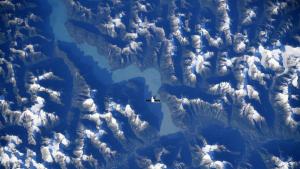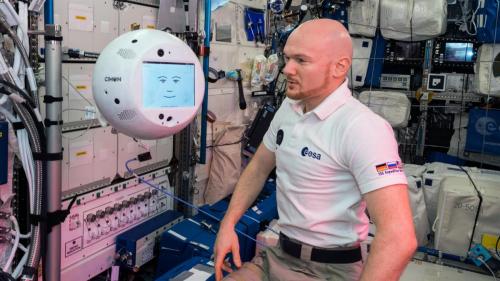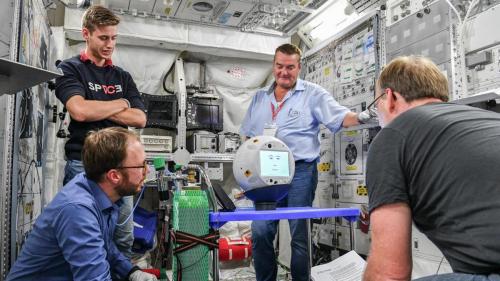CIMON back on Earth after 14 months on the ISS
The Crew Interactive Mobile CompaniON (CIMON) mobile astronaut assistant, which is equipped with artificial intelligence (AI), returned to Earth on 27 August 2019. The SpaceX CRS-18 Dragon spacecraft carrying CIMON was undocked from the International Space Station (ISS) at 16:59 CEST; the capsule splashed down in the Pacific Ocean approximately 480 kilometres southwest of Los Angeles and was recovered at 22:21 CEST.

Dragon capsule with CIMON on board.
"We expect CIMON to return to Germany at the end of October," reports Christian Karrasch, CIMON Project Manager at the German Aerospace Center (Deutsches Zentrum für Luft- und Raumfahrt; DLR) Space Administration. He looks back on the past few months: "CIMON is a technology demonstration that has completely met our expectations. During its initial operation in space – a 90-minute mission with the German ESA astronaut Alexander Gerst on the ISS in November 2018 – it showed that it functions well in microgravity conditions and can interact successfully with astronauts. We are very proud to have been the first to use AI on the Space Station and have been working for several months on an improved successor model. With CIMON, we were able to lay the foundations for human assistance systems in space to support astronauts in their tasks and perhaps, in the future, to take over some of their work."

CIMON and Alexander Gerst.
The new CIMON – like its predecessor – will be built by Airbus in Friedrichshafen and Bremen on behalf of the DLR Space Administration with funds from the German Federal Ministry of Economic Affairs and Energy (BMWi). Airbus in Friedrichshafen has assembled and tested the new CIMON hardware. Airbus in Bremen is working on improving the software for flight and attitude control, while IBM is implementing new functions for the AI. Till Eisenberg, CIMON Project Manager at Airbus says: "Overall, there are several upgrades such as better microphones, a more robust computer, improved flight and attitude control, and new software features for conversation, such as speech recognition, call history and intent analysis."

The new CIMON during tests inside the Columbus laboratory training model.
Matthias Biniok, Project Manager at IBM, adds: “With CIMON we have a unique application case in an extreme working environment. We have seen that we can use AI – in our case IBM Watson – to support the work of astronauts. The further development of CIMON will primarily address improved contextual language comprehension and linguistic emotional analysis.”
Ethical questions concerning the future use of CIMON will be examined and evaluated by physicians at Ludwig-Maximilians University (LMU) in Munich. Personal rights are impacted through the interaction between human and machine, because images and audio of the astronaut are recorded, processed and interpreted by CIMON. High technical standards in the field of data security are necessary, and trust in such a system is important when working in a team consisting of humans and machines. Specifically, what is CIMON allowed to do, know and say? "The new CIMON has a built-in switch that enables the data streams from all cameras and microphones to be interrupted from the ISS. The astronaut has control over CIMON at all times, which was especially important for us," stresses LMU researcher Judith Buchheim.
The DLR Space Administration, which manages Germany's contributions to the European Space Agency (ESA), is working with ESA to deliver the new CIMON to the ISS in December 2019 and to obtain crew time with astronauts.
CIMON arrived on the ISS as a technology demonstration on 2 July 2018. On 15 November 2018, the robotic assistant with the smart 'face' undertook its globally acclaimed mission. For 90 minutes, it 'worked' successfully with Alexander Gerst. CIMON proved its basic functionality – its flight characteristics in microgravity – with autonomous navigation through several rotations and movements in all directions. It also searched for and recognised Gerst's face, made eye contact with him, and spoke to him. Additionally, CIMON displayed the instructions for an experiment on its screen, played music, and acquired video and images of the astronaut.
Source: German Aerospace Center (DLR)
- 262 reads
Human Rights
Fostering a More Humane World: The 28th Eurasian Economic Summi

Conscience, Hope, and Action: Keys to Global Peace and Sustainability

Ringing FOWPAL’s Peace Bell for the World:Nobel Peace Prize Laureates’ Visions and Actions

Protecting the World’s Cultural Diversity for a Sustainable Future

Puppet Show I International Friendship Day 2020

